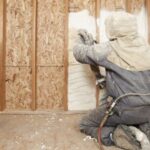Can Spray Foam Insulation Prevent Mold?

Spray foam insulation is indeed a success in preventing mold growth in homes, thanks to its ability to form a sealant and moisture-resistant barrier. In order for mold to thrive, it needs certain environmental conditions, such as moisture, heat, and exposed organic materials. Spray foam insulation can prevent mold directly, because it eliminates two of the crucial conditions for its growth.
How Spray Foam Insulation Prevents Mold
- Moisture Resistance: Insulation made of closed-cell spray foam is very resistant to water intrusion. Closed-cell foam creates a watertight barrier in contrast to conventional insulation materials like fiberglass or cellulose, which can absorb water and provide the perfect conditions for the growth of mold. This makes it a great option for places like crawl spaces, basements, and attics that are prone to moisture or leaks.
- Air Sealing: When applied, spray foam insulation expands to fill in cracks, gaps, and even the smallest crevices. A constant air barrier is produced by this expansion, keeping humid air and moisture from the outside from entering the structure. The likelihood of condensation accumulating in walls, floors, or ceilings is much decreased in the absence of this air exchange, which also reduces the possibility of mold formation.
- Temperature Stability: Spray foam insulation creates an air barrier that keeps indoor temperatures steady. Spray foam keeps outside air out of the house, reducing temperature swings that can generate condensation on cold surfaces, which is the main source of mold and interior humidity.
Benefits of Mold Prevention in Practice
Here’s a breakdown of how closed-cell and open-cell spray foam differ in mold prevention:
| Feature | Closed-Cell Spray Foam | Open-Cell Spray Foam |
|---|---|---|
| Moisture Resistance | High (water-resistant barrier) | Moderate (more permeable to moisture) |
| Ideal Application Areas | Basements, attics, exterior walls | Interior walls, soundproofing applications |
| Durability | Adds structural support, long-lasting | Flexible but less robust against moisture |
Practical Aspects
Particularly in older homes or in areas with high humidity, homeowners who have installed closed-cell spray foam insulation report observable improvements in interior humidity and moisture problems. Many discover that it lessens the possibility of mold development occurring behind walls, particularly in places where leaks or water damage may otherwise go unnoticed for a long time.
A great investment for anyone looking to address mold-prone areas is closed-cell spray foam insulation. It is energy efficient, strengthens the structure where the installation took place and acts as a barrier against moisture. However, it’s crucial to ensure that the insulation is installed by trained professionals, as poor installation can leave gaps or uneven coatings that can diminish its effectiveness.
Bottom Line
Spray foam insulation is a great way to prevent mold growth, especially if you use closed-cell spray foam. By regulating moisture and air penetration, it creates a more stable, dry environment, reducing the likelihood of mold growth in vulnerable areas. Spray foam insulation is an option for anyone looking for long-term mold prevention that blends strength, effectiveness, and comfort.
For professional, reliable garage door services, contact Seamless Systems. We’re here to help with all your garage door needs! Call us at (307) 680-6103




